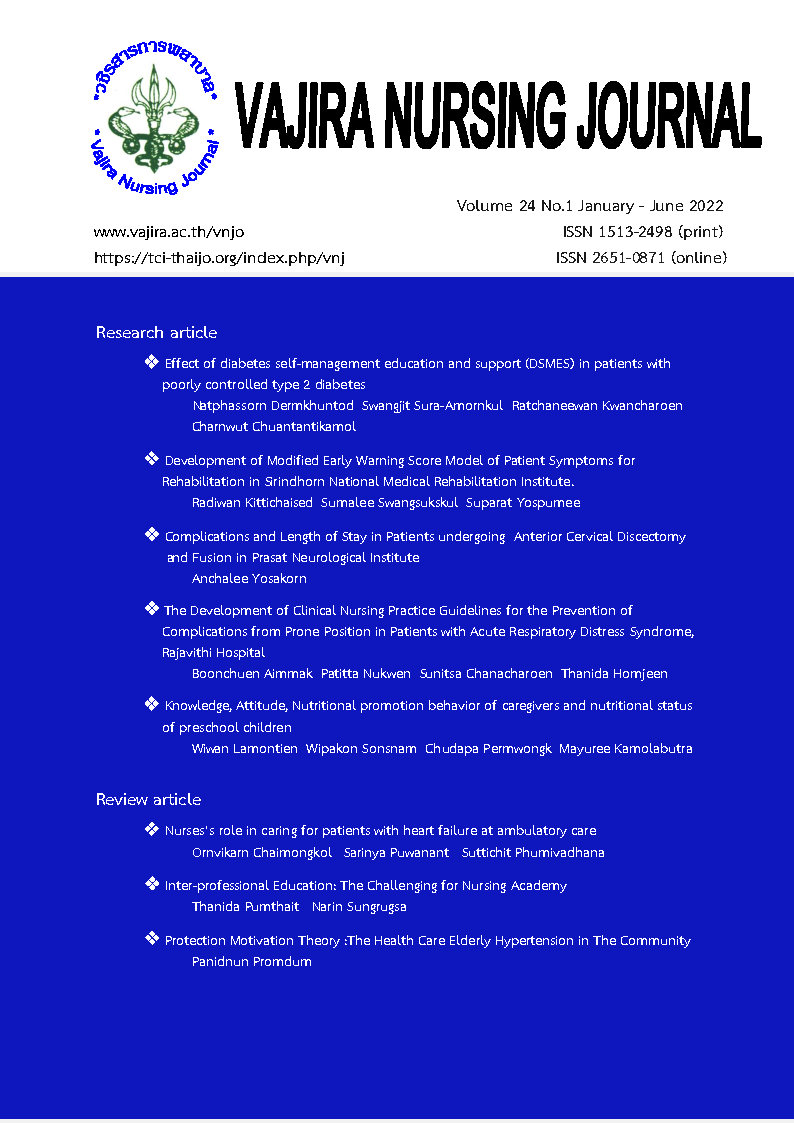ความรู้ ทัศนคติ พฤติกรรมการสร้างเสริมโภชนาการของผู้ดูแล และระดับภาวะโภชนาการของเด็กก่อนวัยเรียน
Main Article Content
บทคัดย่อ
วัตถุประสงค์: เพื่อศึกษาความรู้ ทัศนคติ พฤติกรรมการสร้างเสริมโภชนาการของผู้ดูแลเด็กก่อนวัยเรียนและระดับภาวะโภชนาการของเด็กก่อนวัยเรียน วิธีดำเนินการวิจัย: เป็นการศึกษาวิจัยเชิงสำรวจ โดยกลุ่มตัวอย่างเป็นผู้ดูแลเด็กก่อนวัยเรียน จำนวน 100 คน และเด็กก่อนวัยเรียน จำนวน 100 คน การเข้าถึงกลุ่มตัวอย่างใช้การสุ่มอย่างง่าย (Simple Random Sampling) ในการเลือกแหล่งในการเก็บข้อมูล ในของกลุ่มตัวอย่างคือผู้ดูแลเด็กก่อนวัยเรียนและเด็กก่อนวัยเรียนนั้นตามความสมัครใจ เครื่องมือที่ใช้ในการรวบรวมข้อมูลเกี่ยวกับระดับภาวะโภชนาการได้แก่ เครื่องชั่งน้ำหนัก แถบวัดส่วนสูง กราฟการเจริญเติบโตตามเกณฑ์ช่วงอายุ ของกระทรวงสาธารณสุข ส่วนข้อมูลทั่วไป ความรู้ ทัศนคติ และพฤติกรรมการส่งเสริมโภชนาการเด็กวัยก่อนเรียนของผู้ปกครองหรือผู้ดูแลเด็กวัยก่อนเรียนนั้นรวบรวมข้อมูลด้วยแบบสอบถามซึ่งคณะผู้วิจัยสร้างขึ้น ประกอบด้วย 4 ส่วน โดยเป็นมาตราส่วนประเมินค่า (Rating Scale) ซึ่งผ่านการหาความตรงของเนื้อหา ได้แก่ค่า IOC และทดสอบเครื่องมทอ จำนวน 30 คน มีค่าความเชื่อมั่นสมประสิทธิอัลฟ่า (α -Coefficient) ของครอนบาค เท่ากับ 0.861 ผลการวิจัย: พบว่าผู้ดูแลเด็กวัยก่อนเรียนส่วนใหญ่ร้อยละ 56 คือมารดา รองลงมาคืออื่นๆ คิดเป็นร้อยละ 22 ได้แก่ ยาย ย่า ญาติ เป็นต้น ผู้ดูแลเด็กส่วนใหญ่ร้อยละ 88 มีความรู้เกี่ยวกับการสร้างเสริมการบริโภคอาหารแก่เด็กก่อนวัยเรียนอยู่ในระดับดีมาก คิดเป็นร้อยละ 12 มีระดับทัศนคติต่อการสร้างเสริมการบริโภคอาหารแก่เด็กก่อนวัยเรียนในระดับดีมากเป็นส่วนใหญ่ คิดเป็น
ร้อยละ 87 รองลงมาเป็นระดับดี คิดเป็นร้อยละ 13 นอกจากนี้ส่วนใหญ่ร้อยละ 86 มีพฤติกรรมการสร้างเสริมการบริโภคอาหารอยู่ระดับดีมาก รองลงมาเป็นระดับดีคิดเป็นร้อยละ 14 ระดับภาวะโภชนาการของเด็กก่อนวัยเรียน ส่วนใหญ่ร้อยละ 52 อยู่ในระดับสมส่วน รองลงมาคือผอม คิดเป็นร้อยละ 28 สรุป: ผู้ดูแลเด็กวัยก่อนเรียนมีความรู้ ทัศนคติ และพฤติกรรมการสร้างเสริมการบริโภคอาหารเด็ก วัยก่อนเรียนในความดูแลอยู่ในระดับดีถึงดีมาก ระดับภาวะโภชนาการของเด็กก่อนวัยเรียนส่วนใหญ่อยู่ในระดับสมส่วน รองลงมาผอม แต่ยังพบว่ามีกลุ่มที่เริ่มอ้วน อ้วน และท้วม ตามลำดับจากมากไปหาน้อยร่วมด้วย ผู้วิจัยจึงเห็นความสำคัญชองการศึกษาในครั้งนี้เนื่องจากการแก้ไขปัญหาหรือการพัฒนาเด็กก่อนวัยเรียนซึ่งจะเติบโตเป็นทรัพยากรที่สำคัญของประเทศต่อไปนั้นผู้ดูแลเด็กมีความสำคัญยิ่งเนื่องจากเด็กก่อนวัยเรียนเป็นกลุ่มที่ต้องพึ่งพิงยังไม่สามารถดูแลตนเองได้
Article Details

อนุญาตภายใต้เงื่อนไข Creative Commons Attribution-NonCommercial-NoDerivatives 4.0 International License.
เนื้อหาและข้อมูลในบทความที่ลงตีพิมพ์ในวชิรสารการพยาบาลถือเป็นข้อคิดเห็นและความรับผิดชอบของผู้เขียนบทความโดยตรง ซึ่งกองบรรณาธิการไม่จำเป็นต้องเห็นด้วย หรือร่วมรับผิดชอบใด ๆ ทั้งสิ้น
บทความ ข้อมูล เนื้อหา รูปภาพ ฯลฯ ที่ได้รับการตีพิมพ์ในวชิรสารการพยาบาล ถือเป็นลิขสิทธิ์ของวชิรสารการพยาบาล หากบุคคลใดหรือหน่วยงานใดต้องการนำทั้งหมดหรือส่วนหนึ่งส่วนใดไปเผยแพร่ต่อหรือเพื่อกระทำการใด ๆ จะต้องได้รับอนุญาตเป็นลายลักอักษรจากวชิรสารการพยาบาลก่อนเท่านั้น
เอกสารอ้างอิง
กุสุมา ชูศิลป์. (2552). โรคอ้วนในเด็ก. ใน สุชาติ เกิดผล, อวยพร ปะนะมณฑา, จามรี
ธีรตกุลพิศาล, ชาญชัย พาทอง วิริยะกุล, ณรงค์ เอื้อวิชญาแพทย์ และจรรยา จิระประดิษฐา (บรรณาธิการ), วิชากุมารเวชศาสตร์ เล่ม 3. (พิมพ์ครั้งที่ 4). ขอนแก่น: แอนนาออฟเซต.
จันท์ฑิตา พฤษานานนท์. (2545). อ้วนอันตราย ตอน: โรคที่มากับความอ้วน. ใกล้หมอ, 26(5), 90-91.
ถวิล สกุลวรรณวงศ์ และภูเบศร์ แสงสว่าง. (2560). การดูแลการบริโภคอาหารโดยผู้ปกครองกับภาวะโภชนาการ ของเด็กวัยเรียนในอำเภองาว จังหวัดลำปาง.
ทักษพล ธรรมรังสี. (2558). อาหารและโภชนาการในประเทศไทย: เราอยู่ตรงจุดใดในปัจจุบัน 2015. แผนงานวิจัยนโยบายอาหารและโภชนาการ. สำนักงานกองทุนสนับสนุนการสร้างเสริมสุขภาพ.
ลัดดา เหมาะสุวรรณ. (2551-2). ภาวะโภชนาการเด็ก. รายงานการสำรวจสุขภาวะของประชาชนโดยการตรวจร่างกาย ครั้งที่ 4 พ.ศ.2551-2, หน้า 105-125.
ลัดดา เหมาะสุวรรณ. (2557). แนวทางการดำเนินงานเฝ้าระวังโภชนาการหญิงตั้งครรภ์และการเจริญเติบโตของเด็กแรกเกิด – 5 ปี. กรมอนามัย. กระทรวงสาธารณสุข. กรุงเทพฯ: โรงพิมพ์องค์กรรับส่งสินค้าและพัสดุภัณฑ์ (ร.ส.พ.).
มณีรัตน์ ภาคธูป และรัชนีวรรณ รอส. (2549). สาเหตุและผลของความอ้วนกับการจัดการกับความอ้วน การวิจัยเชิงคุณภาพแบบพรรณนาในเด็กที่มีภาวะอ้วนในเขตจังหวัดชลลบุรี. วารสารคณะพยาบาลศาสตร์ มหาวิทยาลัยบูรพา, 14(2), 34-48.
ศิริพร สุริวงษ์. (2549). ปัจจัยเชิงสาเหตุที่มีอิทธิพลต่อการมีน้ำาหนักเกินเกณฑ์ของเด็ก
ปฐมวัยในโรงเรียน ประถมศึกษา สังกัดกรุงเทพมหานคร. ปริญญานิพนธ์การศึกษามหาบัณฑิต, สาขาการศึกษาปฐมวัย, บัณฑิตวิทยาลัย, มหาวิทยาลัยศรีนครินทรวิโรฒ.
สถาบันวิจัยประชากรและสังคม มหาวิทยาลัยมหิดล (วปส.). (2557). สุขภาพคนไทย 2557: ชุมชนท้องถิ่นจัดการตนเอง สู่การปฏิรูปประเทศจากฐานราก. (พิมพ์ครั้งที่ 1). กรุงเทพฯ: บริษัทอมรินทร์พริ้นติ้งแอนด์พับลิซซิ่ง จำกัด (มหาชน).
สโรชา นันทพงศ์, นฤมล ศราธพันธุ์ และอภิญญา หิรัญวงษ์. (2557). ความรู้เกี่ยวกับโภชนการและพฤติกรรมการจัดอาหารสำหรับเด็กวัยก่อนเรียนของผู้ปกครองโรงเรียนรัฐบาล จังหวัดชุมพร. วารสารเกษตรศาสตร์ (สังคม), 35(2): 235-244.
สุชา จันทน์เอม. (2541). จิตวิทยาเด็ก. (พิมพ์ครั้งที่ 3). กรุงเทพฯ: โรงพิมพ์ไทยวัฒนาพานิช.
สำนักงานคณะกรรมการพัฒนาเศรษฐกิจและสังคมแห่งชาติ. (2554). แผนพัฒนาเศรษฐกิจและสังคมแห่งชาติ ฉบับที่ 11 พ.ศ. 2555-2559. กรุงเทพมหานคร: สหมิตรพริ้นติ้งแอนด์พับลิซซิ่ง.
สำนักงานสถิติแห่งชาติ. (2555). การสำรวจสถานการณ์เด็กและสตรีในประเทศไทย พ.ศ. 2555. กรุงเทพฯ.
อรุณี ไรปิ่น, ยุนี พงศ์จตุรวิทย และ นฤมล ธีระรังสิกุล. (2555). ความคิดเห็นและการปฏิบัติของมารดาบุตรวัยก่อนเรียนที่มีภาวะโภชนาการเกิน. วารสารหาวิทยาลัยสงขลานครินทร์, 4(2): 1-15.
อำไพพรรณ ปัญญาโรจน์. (2545). การอบรมเลี้ยงดูเด็กก่อนวัยเรียน. กรุงเทพฯ: คณะวิทยาศาสตร์และเทคโนโลยี สถาบันราชภัฏจันทรเกษม.
Birch, L.L. & Fisher, J.O. (1998). Development of eating behaviors among children and adolescents. Pediatrics, 101, 539-549.
Birch, L.L. (1999). Development of food preferrences. Annual Review of Nutrition, 19, 41-62.
Coleman, G., et al., (2005). Nutrition education aimed at toddlers (NEAT) curriculum. Journal of Nutrition Education and Behavior, 37, 96-97.
Davison, K., & Birch, L.L. (2001). Childhood overweight: A contextual model and recommendations for future research. Obesity Review, 2(3), 159-171.
Georgieff, M.K. (2007). Nutrition and Developing Brain: Nutrient Priorities and Measurement, American Journal Clinical Nutrition, 85(2): 614S-620S.
Kangwon, C., & Teeraanurak, J., P. (2015). Parental Role in Promoting Eating Behavior of Kindergarten Children in Petchaburi Kindergarten. An Online Journal of Education, 10(2): 87-97. (in Thai).
Mosuwan, L. (2013). How to care obese children. Retrieved from http://nutrition .anamai. moph.go.th/ewt_news.php?nid =114 [In Thai].
Ministry of Public Health. (1999). Guidelines for using weight reference criteria to evaluate the growth of Thai children. Bangkok: Ministry of public health. [In Thai].
Nimnuan, P. (2012). Measurement and Evaluation of Competencies and Skill Based on the Focus on Quality Development. “Read out”. Academic and Educational Standards office of the Basic Education Commission, Ministry of Education Retrieved 1 October 2020. From https://www.slidshare. net/payungn.
Ontario public health association. (2009). Eat right be active. Ontario: Nutrition Resource Center.
Rosales, F.J., Reznick, J.S., & Zeisel, S.H. (2009). Understanding the Role of Nutrition in the Brain and Behavior Development of Toddlers and Preschool Children: Identifying and Addressing Methodological barriers. Nutrition Neuroscience, 12(5): 102-202.
Sangsawang, J., Chukumnird, S., Chupradit, P., Binthaprasitthi, S., & Wattanasart, Y., (2017). Development of Food Nutrition Management Model for Preschool Children Bared on Mother’s Food Guidelin E: A Participatory Action Research. Journal of Borumarajonani College of Nursing, Bangkok, 32(2): 146-158. (in Thai)
World Health Organization. (2016). World health statistic 2014. January 2, Retrieved from http://apps.who.int/iris/ bitstream/ 10665 /112738/1/9789240 692671_eng.pdf
World Health Organization. (2018). Children’s environmental health. Retrieved from http://www.who.int/ceh/publications/factsheets/fs284/en/.


